Woody Biomass Mobilization for Bioenergy in a Constrained Landscape: A Case Study from Cold Lake First Nations in Alberta, Canada
Abstract
:1. Introduction
Cold Lake First Nations: Land, Culture, History, and Socio-Economical Values
2. Materials and Methods
2.1. Human Footprint Data
2.2. Compilation of Available Biomass Feedstock
2.3. Fire Data
2.4. Socio-Economic Benefits and Pre-Feasibility Study
2.5. Energy Consumption and GHG Emission Mitigation Potential
3. Results
3.1. Human Footprint
3.2. Biomass Available
3.3. Fire History
3.4. Socio-Economic Assessment
3.5. GHG Emissions Mitigation from Bioenergy
4. Discussion
4.1. Challenges of Biomass Mobilization under Overlapping Land Uses
4.2. Socio-Economic and Environmental Challenges
5. Conclusions
Author Contributions
Funding
Acknowledgments
Conflicts of Interest
Appendix A
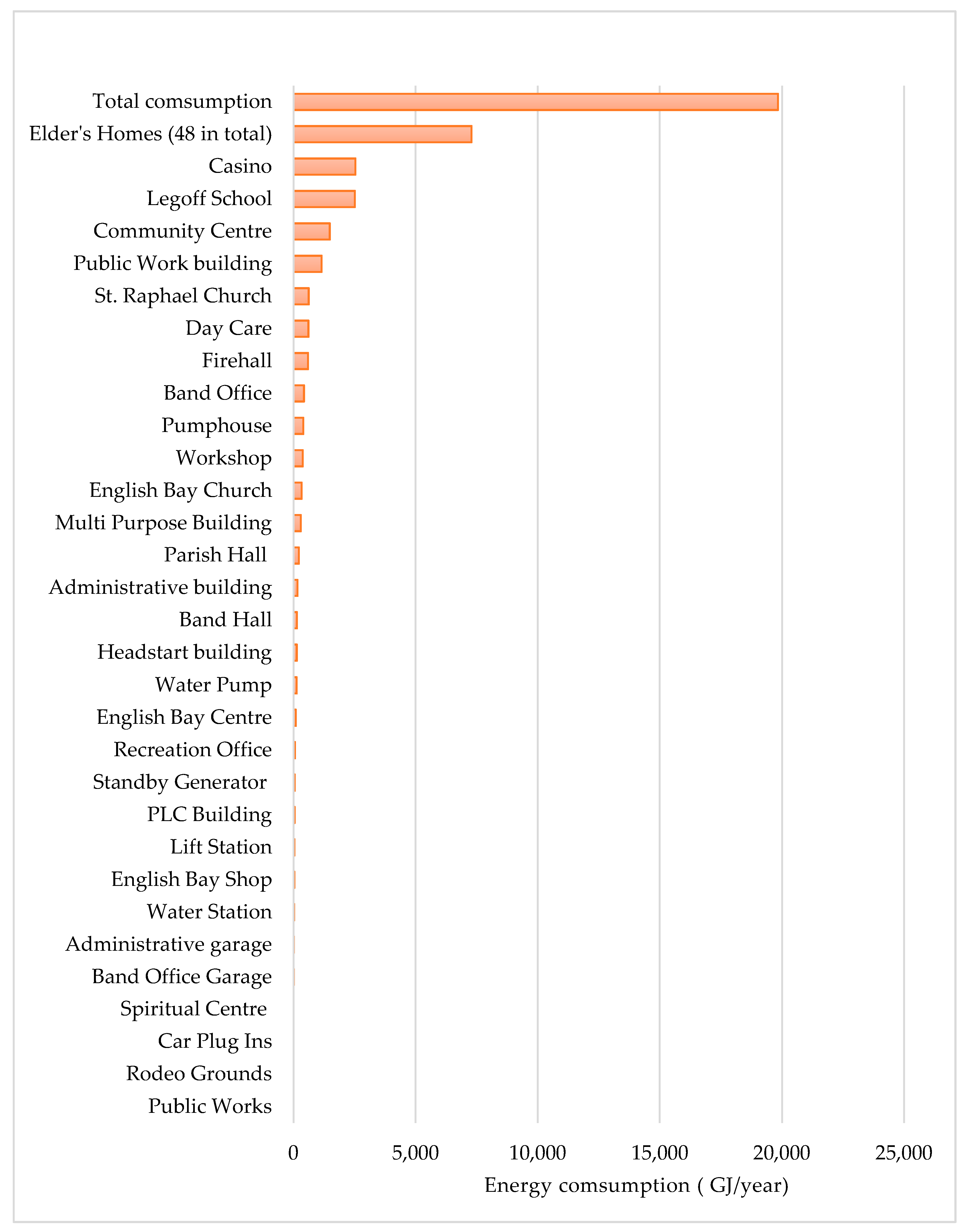
Appendix B
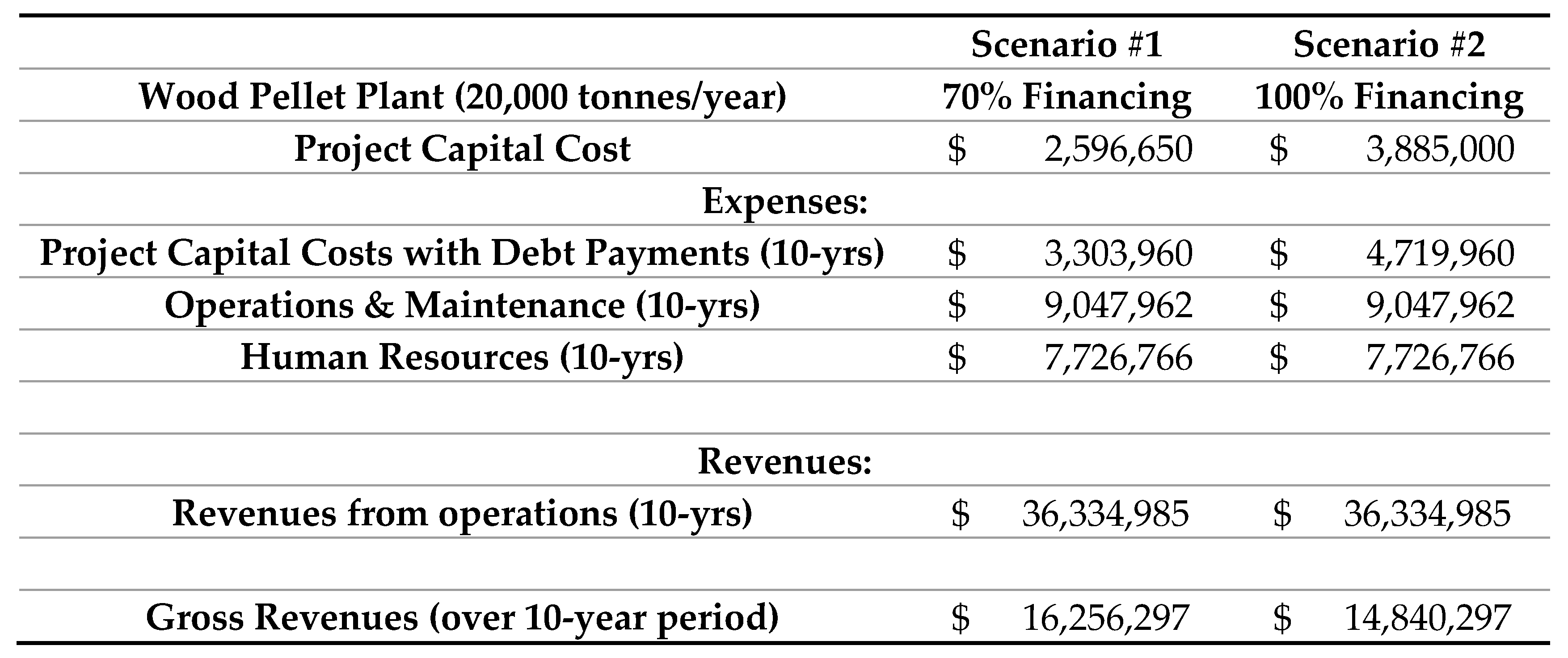
References
- United Nations Development Programme (UNDP). Handbook for Conducting Technology Needs Assessment for Climate Change, New York. 2014. Available online: https://unfccc.int/sites/default/files/1529e639caec4b53a4945ce009921053.pdf (accessed on 4 April 2020).
- A Forest Bioeconomy Framework for Canada; Canadian Council of Forest Ministers: Ottawa, ON, Canada, 2017; 30p.
- Pan Canadian Framework on Clean Growth and Climate Change. Canada’s Plan to Address Climate Change and Grow the Economy; Catalogue no. En4-294/2016E-PDF; Government of Canada: Ottawa, ON, Canada, 2016.
- Statistics Canada. Canada. Aboriginal Population Profile, 2016 Census. Statistics Canada Catalogue no. 98-510-X2016001. Ottawa. Released July 18, 2018. Available online: http://www12.statcan.gc.ca/census-recensement/2016/dp-pd/abpopprof/index.cfm?Lang=E (accessed on 6 January 2020).
- Zurba, M.; Stucker, D.; Mwaura, G.; Burlando, C.; Rastogi, A.; Dhyani, S.; Koss, R. Intergenerational Dialogue, Collaboration, Learning, and Decision-Making in Global Environmental Governance: The Case of the IUCN Intergenerational Partnership for Sustainability. Sustainability 2020, 12, 498. [Google Scholar] [CrossRef] [Green Version]
- Natural Resources Canada. Clean Energy for Rural and Remote Communities: BioHeat, Demonstration & Deployment Program Stream. 2018. Available online: https://www.nrcan.gc.ca/reducingdiesel (accessed on 6 August 2020).
- Coote, D.C.; Thiffault, E.; Brown, M. Constraints and Success Factors for Woody Biomass Energy Systems in Two Countries with Minimal Bioenergy Sectors. In Mobilisation of Forest Bioenergy in the Boreal and Temperate Biomes; Thiffault, E., Smith, C.T., Junginger, M., Berndes, G., Eds.; Academic Press: Cambridge, MA, USA, 2016; pp. 165–189. [Google Scholar]
- Mansuy, N.; Thiffault, E.; Lemieux, S.; Manka, F.; Paré, D.; Lebel, L. Sustainable biomass supply chains from salvage logging of fire-killed stands: A case study for wood pellet production in eastern Canada. Appl. Energy 2015, 154, 62–73. [Google Scholar] [CrossRef]
- Mansuy, N.; Paré, D.; Thiffault, E.; Bernier, P.Y.; Cyr, G.; Manka, F.; Lafleur, B.; Guindon, L. Estimating the spatial distribution and locating hotspots of forest biomass from harvest residues and fire-damaged stands in Canada’s managed forests. Biomass Bioenergy 2017, 97, 90–99. [Google Scholar] [CrossRef]
- Bullock, R.C.; Zurba, M.; Parkins, J.R.; Skudra, M. Open for bioenergy business? Perspectives from Indigenous business leaders on biomass development potential in Canada. Energy Res. Soc. Sci. 2020, 64, 101446. [Google Scholar] [CrossRef]
- Zurba, M.; Bullock, R. Framing indigenous bioenergy partnerships. Int. Indig. Policy J. 2018, 9. [Google Scholar] [CrossRef]
- Henderson, C.; Sanders, C. Powering Reconciliation: A Survey of Indigenous Participation in Canada’s Growing Clean Energy Economy; Lumos Clean Energy Advisors: Ottawa, ON, Canada, 2017. [Google Scholar]
- Stefanelli, R.D.; Walker, C.; Kornelsen, D.; Lewis, D.; Martin, D.H.; Masuda, J.; Castleden, H. Renewable energy and energy autonomy: How Indigenous peoples in Canada are shaping an energy future. Environ. Rev. 2019, 27, 95–105. [Google Scholar] [CrossRef]
- The Ecological Framework of Canada. 2020. Available online: http://ecozones.ca/english/ (accessed on 7 March 2019).
- Cold Lake First Nations Lands and Resources Department. Available online: https://clfns.com/ (accessed on 10 November 2020).
- Alberta Biodiversity Monitoring Institute (ABMI). Status of Human Footprint in Alberta. 2019. Available online: https://abmi.ca/home/reports/2018/human-footprint?#categories (accessed on 1 June 2020).
- Beaudoin, A.; Bernier, P.Y.; Guindon, L.; Villemaire, P.; Guo, X.J.; Stinson, G.; Bergeron, T.; Magnussen, S.; Hall, R.J. Mapping attributes of Canada’s forests at moderate resolution through k NN and MODIS imagery. Can. J. For. Res. 2014, 44, 521–532. [Google Scholar] [CrossRef] [Green Version]
- Edenhofer, O.; Pichs-Madrga, R.; Sokona, Y.; Seyboth, K. Summary for policymakers. In IPCC Special Report on Renewable Energy Sources and Climate Change Mitigation; Cambridge University Press: Cambridge, UK; New York, NY, USA, 2011; pp. 1–24. [Google Scholar]
- Boulanger, Y.; Taylor, A.R.; Price, D.T.; Cyr, D.; McGarrigle, E.; Rammer, W.; Ste-Marie, G.; Beaudoin, A.; Guindon, L.; Mansuy, N. Climate change impacts on forest landscapes along the Canadian southern boreal forest transition zone. Landsc. Ecol. 2016, 32, 1415–1431. [Google Scholar] [CrossRef]
- Natural Resources Canada. Canadian Wildland Fire Information System (CWFIS). 2019. Available online: https://cwfis.cfs.nrcan.gc.ca/home (accessed on 1 August 2019).
- H&W Biogenics Ltd. The Installation of a Wood Pellet Plant and a Wood Fiber Energy System at Cold Lake First Nations. A Prefeasibility Technical Evaluation; H&W Biogenics Ltd.: Edmonton, AB, Canada, 2019. [Google Scholar]
- Statistics Canada. Household Energy Use, by Fuel Type and by Province, 2007—Average Energy Use. 2007. Available online: https://www150.statcan.gc.ca/n1/pub/11-526-s/2010001/t004-eng.htm (accessed on 3 October 2019).
- Laganière, J.; Paré, D.; Thiffault, E.; Bernier, P.Y. Range and uncertainties in estimating delays in greenhouse gas mitigation potential of forest bioenergy sourced from Canadian forests. GCB Bioenergy 2017, 9, 358–369. [Google Scholar] [CrossRef] [Green Version]
- Atkinson, N. Landscapes of the Alberta Oil Sands. In Landscapes and Landforms of Western Canada; Springer: Cham, Switzerland, 2017; pp. 395–410. [Google Scholar]
- Smeets, E.M.; Faaij, A.P.; Lewandowski, I.M.; Turkenburg, W.C. A bottom-up assessment and review of global bio-energy potentials to 2050. Prog. Energy Combust. Sci. 2007, 33, 56–106. [Google Scholar] [CrossRef] [Green Version]
- Dymond, C.C.; Titus, B.D.; Stinson, G.; Kurz, W.A. Future quantities and spatial distribution of harvesting residue and dead wood from natural disturbances in Canada. For. Ecol. Manag. 2010, 260, 181–192. [Google Scholar] [CrossRef]
- Yemshanov, D.; McKenney, D.W.; Hope, E.; Lempriere, T. Renewable energy from forest residues—How greenhouse gas emission offsets can make fossil fuel substitution more attractive. Forests 2018, 9, 79. [Google Scholar] [CrossRef] [Green Version]
- Li, X.; Mupondwa, E.; Panigrahi, S.; Tabil, L.; Sokhansanj, S.; Stumborg, M. A review of agricultural crop residue supply in Canada for cellulosic ethanol production. Renew. Sustain. Energy Rev. 2012, 16, 2954–2965. [Google Scholar] [CrossRef]
- Boucher, B.; Boulanger, Y.; Aubin, I.; Bernier, P.; Beaudoin, A.; Guindon, L.; Gauthier, S. Current and projected cumulative impacts of fire, drought, and insects on timber volumes across Canada. Ecol. Appl. 2018, 28, 1245–1259. [Google Scholar] [CrossRef]
- Lamers, P.; Junginger, M. The ‘debt’ is in the detail: A synthesis of recent temporal forest carbon analyses on woody biomass for energy. Biofuels Bioprod. Biorefin. 2013, 7, 373–385. [Google Scholar] [CrossRef]
- Lamers, P.; Junginger, M.; Dymond, C.C.; Faaij, A. Damaged forests provide an opportunity to mitigate climate change. Glob. Chang. Biol. Bioenergy 2014, 6, 44–60. [Google Scholar] [CrossRef]
- Paré, D.; Bernier, P.; Thiffault, E.; Titus, B. The potential of forestry biomass as a source of energy for Canada. For. Chron. 2011, 87, 345–350. [Google Scholar] [CrossRef] [Green Version]
- Zhang, J.; Huang, S.; Hogg, E.H.; Lieffers, V.; Qin, Y.; He, F. Estimating spatial variation in Alberta forest biomass from a combination of forest inventory and remote sensing data. Biogeosciences 2014, 11, 2793. [Google Scholar] [CrossRef] [Green Version]
- Barrette, J.; Paré, D.; Manka, F.; Guindon, L.; Bernier, P.; Titus, B. Forecasting the Spatial Distribution of Logging Residues Across the Canadian Managed Forest. Can. J. For. Res. 2018, 48, 1470–1481. [Google Scholar] [CrossRef]
- Krupa, J. Identifying barriers to Aboriginal renewable energy development in Canada. Energy Policy 2012, 42, 710–714. [Google Scholar] [CrossRef]
- Hervieux, D.; Hebblewhite, M.; Stepnisky, D.; Bacon, M.; Boutin, S. Managing wolves (Canis lupus) to recover threatened woodland caribou (Rangifer tarandus caribou) in Alberta. Can. J. Zool. 2014, 92. [Google Scholar] [CrossRef] [Green Version]
- Thorn, S.; Bässler, C.; Brandl, R.; Burton, P.J.; Cahall, R.; Campbell, J.L.; Castro, J.; Choi, C.Y.; Cobb, T.; Donato, D.C.; et al. Impacts of salvage logging on biodiversity: A meta-analysis. J. Appl. Ecol. 2018, 55, 279–289. [Google Scholar] [CrossRef] [PubMed]
- Yemshanov, D.; Haight, R.G.; Liu, N.; Parisien, M.A.; Barber, Q.; Koch, F.H.; Burton, C.; Mansuy, N.; Campioni, F.; Choudhury, S. Assessing the trade-offs between timber supply and wildlife protection goals in boreal landscapes. Can. J. For. Res. 2019, 50, 243–258. [Google Scholar] [CrossRef]
- Mansuy, N.; Barrette, J.; Laganière, J.; Mabee, W.; Paré, D.; Gautam, S.; Thiffault, E.; Ghafghazi, S. Salvage harvesting for bioenergy in Canada: From sustainable and integrated supply chain to climate change mitigation. Wiley Interdiscip. Rev. Energy Environ. 2018, 7, e298. [Google Scholar] [CrossRef]
- McGregor, D. Aboriginal/Non-Aboriginal Relations and Sustainable Forest Management in Canada: Ten years since the Royal Commission. J. Environ. Manag. 2011, 92, 3000–3010. [Google Scholar] [CrossRef]
- Smith, D.W.; Bibeau, E.L.; Tampier, M. Community-Based Model for Forest Land Management and Bioenergy Production Using a Distributed CHP System. 2006. Available online: http://home.cc.umanitoba.ca/~bibeauel/research/papers/2006_Bibeau_bioenergy2006.pdf (accessed on 3 March 2010).
- Berkes, F.; Berkes, M.K.; Fast, H. Collaborative integrated management in Canada’s north: The role of local and traditional knowledge and community-based monitoring. Coast. Manag. 2007, 35, 143–162. [Google Scholar] [CrossRef]
- Sandlos, J.; Keeling, A. Aboriginal communities, traditional knowledge, and the environmental legacies of extractive development in Canada. Extr. Ind. Soc. 2016, 3, 278–287. [Google Scholar] [CrossRef]
- Cooke, S.J.; Rice, J.C.; Prior, K.A.; Bloom, R.; Jensen, O.; Browne, D.R.; Donaldson, L.A.; Bennett, J.R.; Vermaire, J.C.; Auld, G. The Canadian context for evidence-based conservation and environmental management. Environ. Evid. 2016, 5, 14. [Google Scholar] [CrossRef] [Green Version]
- Mansuy, N.; Burton, P.J.; Stanturf, J.; Beatty, C.; Mooney, C.; Besseau, P.; Degenhardt, D.; MacAfee, K.; Lapointe, R. Scaling up forest landscape restoration in Canada in an era of cumulative effects and climate change. For. Policy Econ. 2020, 116, 102177. [Google Scholar] [CrossRef]
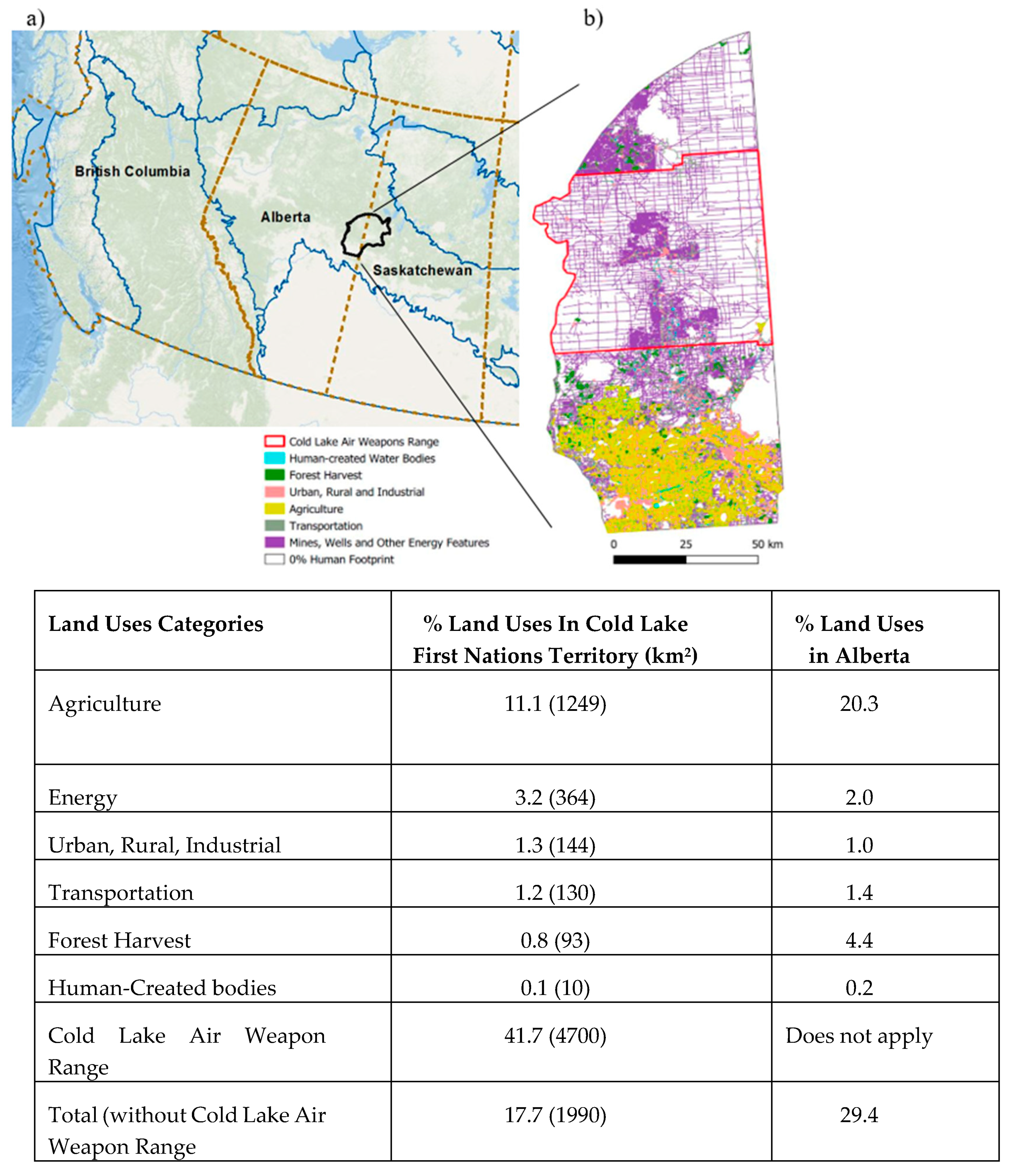
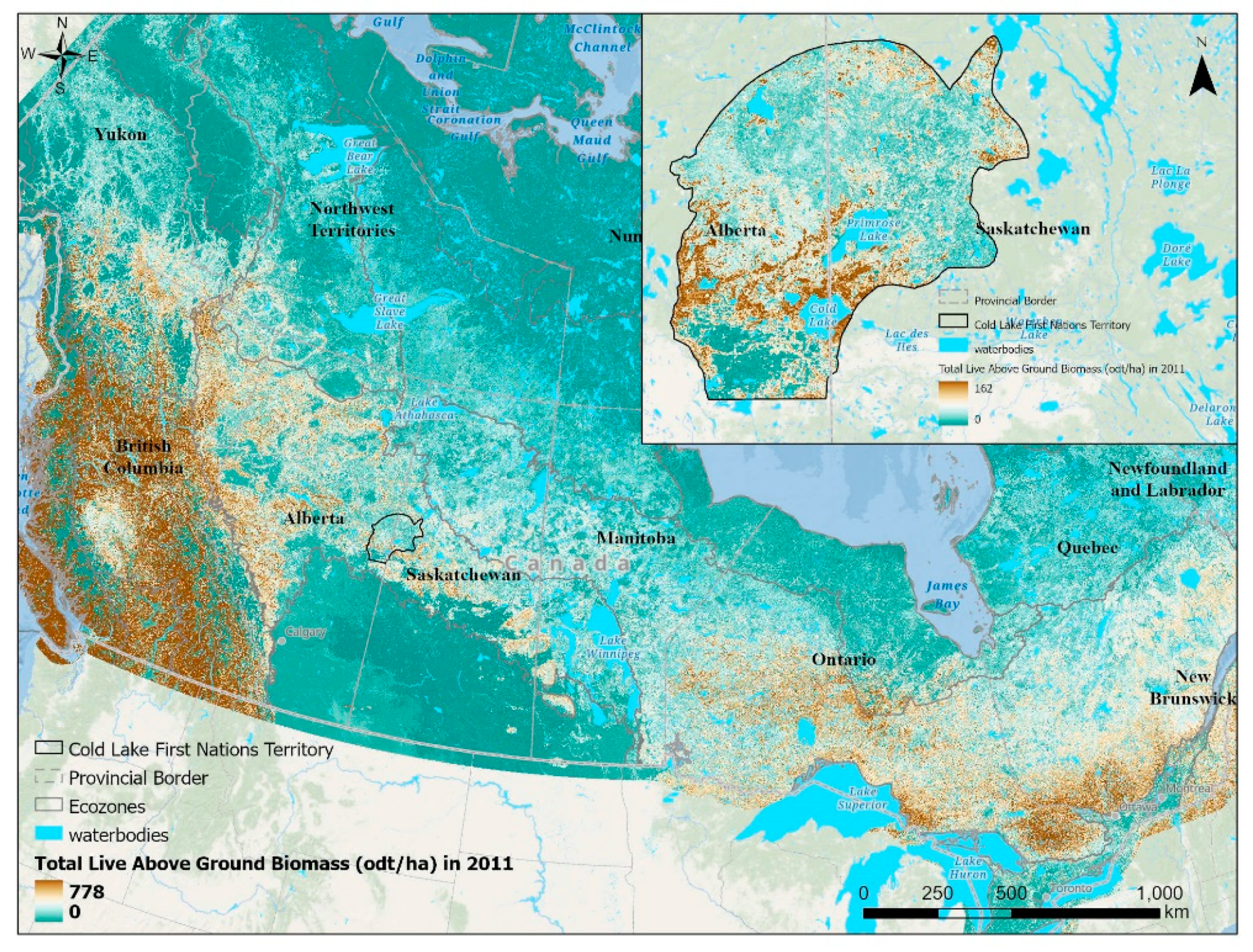
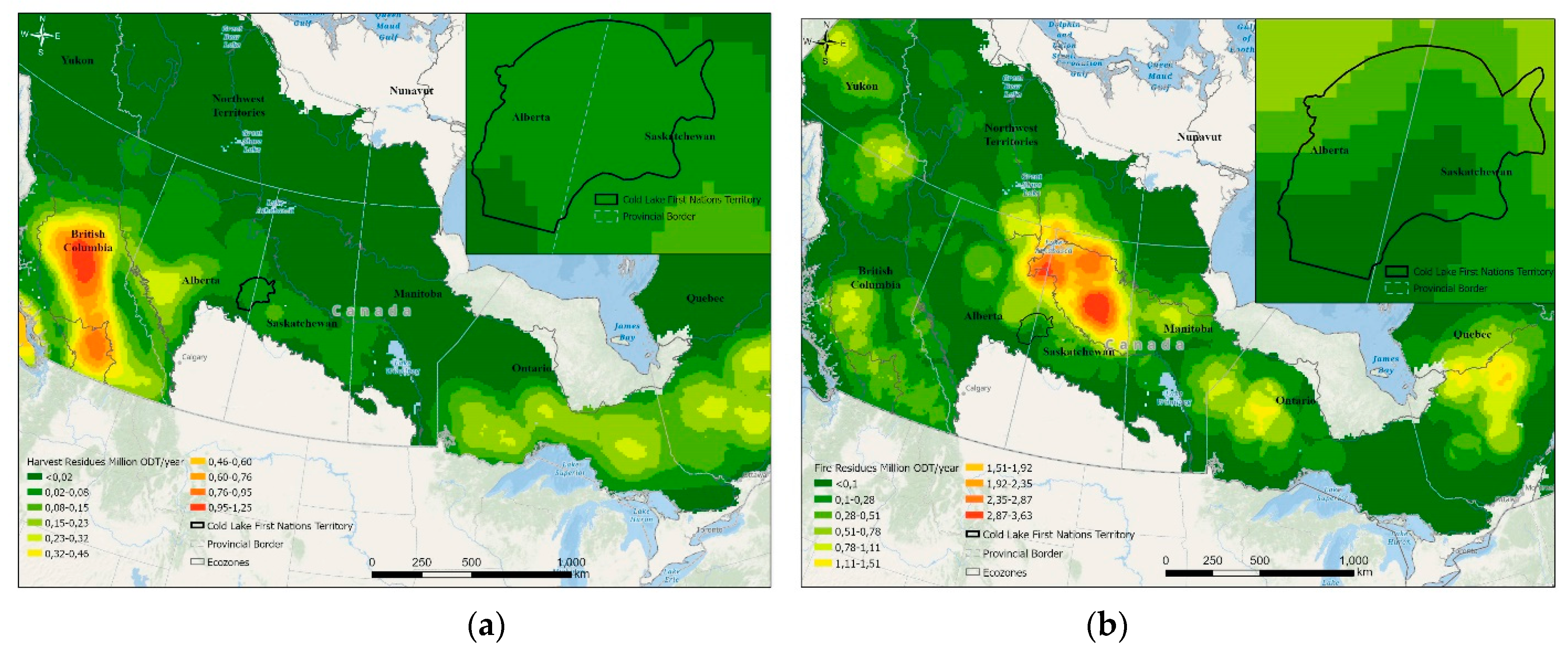

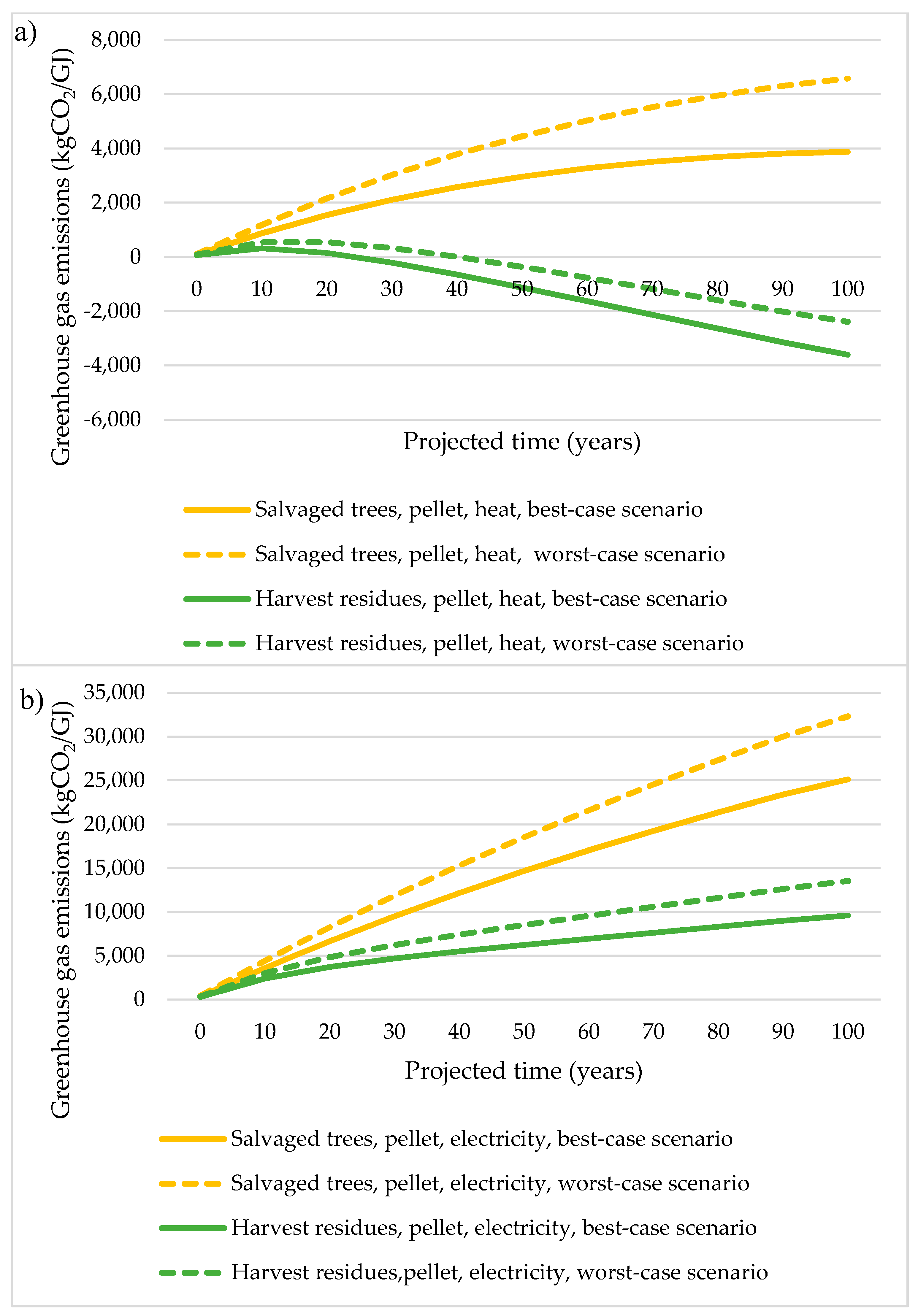
| Model Parameters | Description |
|---|---|
| Feedstock considered | Salvaged trees: Salvaged trees are defined as standing trees killed by natural disturbances. The stemwood is harvested for bioenergy, while the residues are left on site (i.e., what happens to the residues is not considered in the calculation). When salvaged trees are not used to produce bioenergy, the model assumes that they are left on site to decompose. Silvicultural practices (e.g., site preparation, tree planting, weed control) may increase forest regeneration and growth following biomass harvesting. Harvest residues: Harvest residues are defined as all woody debris generated in harvesting operations for traditional wood products (e.g., branches, tree tops, bark), excluding stumps and downed non-merchantable trees. When harvest residues are not used to produce bioenergy, the model assumes that they are left on site to decompose. |
| Mean annual temperature | 1 °C degrees (estimated at Cold Lake airport) |
| Transformation feedstock | Wood pellets: A2 grade, moisture 8% wet basis. Higher heating value (HHV) = 16.5 MJ/kg (4.6 kWh/kg). |
| Place of use | Local market (no transportation) |
| Energy conversion | Heat or electricity |
| Bioenergy system conversion | 75% |
| Fossil fuel replaced | Natural gas |
| Fossil fuel system efficiency | 85% |
| Types of Feedstock | Harvest Residues | Fire Residues | Forestry Residues from Oil and Gas Activities * |
|---|---|---|---|
| Amount of Residue | 18 odt/ha | 39 odt/ha | 19,000 odt/year |
Publisher’s Note: MDPI stays neutral with regard to jurisdictional claims in published maps and institutional affiliations. |
© 2020 by the authors. Licensee MDPI, Basel, Switzerland. This article is an open access article distributed under the terms and conditions of the Creative Commons Attribution (CC BY) license (http://creativecommons.org/licenses/by/4.0/).
Share and Cite
Mansuy, N.; Staley, D.; Taheriazad, L. Woody Biomass Mobilization for Bioenergy in a Constrained Landscape: A Case Study from Cold Lake First Nations in Alberta, Canada. Energies 2020, 13, 6289. https://doi.org/10.3390/en13236289
Mansuy N, Staley D, Taheriazad L. Woody Biomass Mobilization for Bioenergy in a Constrained Landscape: A Case Study from Cold Lake First Nations in Alberta, Canada. Energies. 2020; 13(23):6289. https://doi.org/10.3390/en13236289
Chicago/Turabian StyleMansuy, Nicolas, Diana Staley, and Leila Taheriazad. 2020. "Woody Biomass Mobilization for Bioenergy in a Constrained Landscape: A Case Study from Cold Lake First Nations in Alberta, Canada" Energies 13, no. 23: 6289. https://doi.org/10.3390/en13236289




